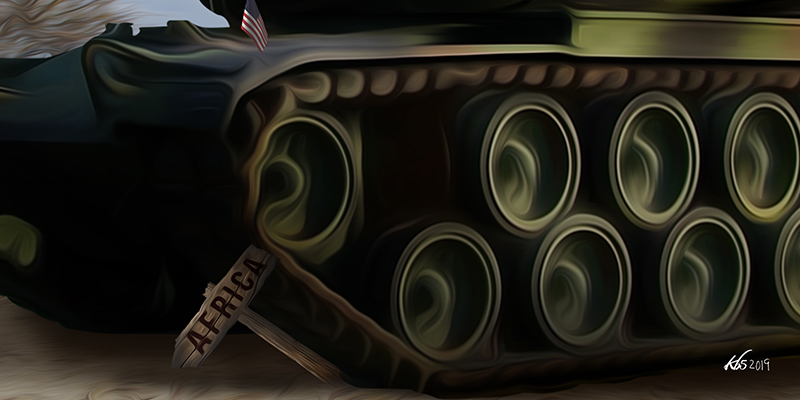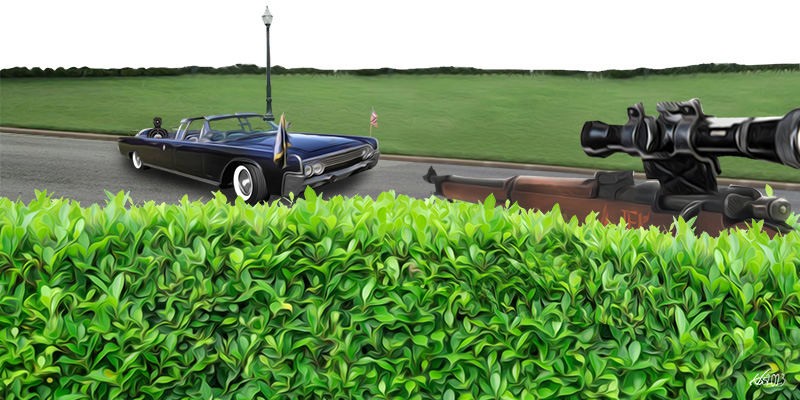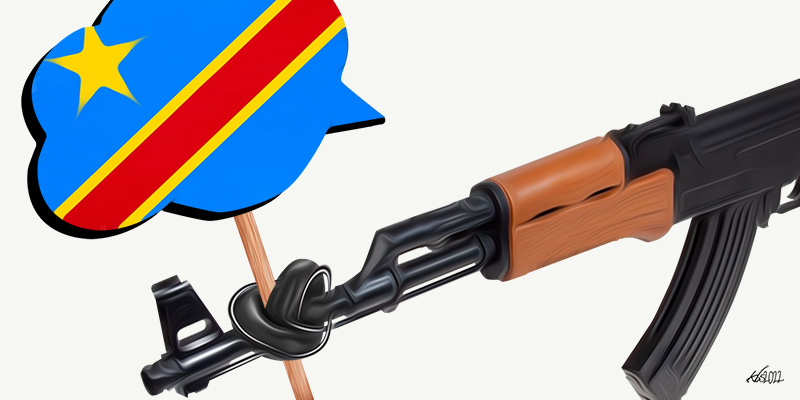In late January, reports circulated on social media about a suspected US drone strike in southern Somalia, in the Al-Shabaab controlled Ma’moodow town in Bakool province. Debate quickly ensued on Twitter about whether the newly installed Biden administration was responsible for this strike, which was reported to have occurred at 10 p.m. local time on January 29th, 2021.
Southern Somalia has been the target of an unprecedented escalation of US drone strikes in the last several years, with approximately 900 to 1,000 people killed between 2016 and 2019. According to the nonprofit group Airwars, which monitors and assesses civilian harm from airpower-dominated international military actions, “it was under the Obama administration that a significant US drone and airstrike campaign began,” coupled with the deployment of Special Operations forces inside the country.
Soon after Donald Trump took office in 2017, he signed a directive designating parts of Somalia “areas of active hostilities.” While the US never formally declared war in Somalia, Trump effectively instituted war-zone targeting rules by expanding the discretionary authority of the military to conduct airstrikes and raids. Thus the debate over the January 29 strike largely hinged on the question of whether President Joe Biden was upholding Trump’s “flexible” approach to drone warfare―one that sanctioned more airstrikes in Somalia in the first seven months of 2020 than were carried out during the administrations of George W. Bush and Barack Obama, combined.
In the days following the January 29 strike, the US Military’s Africa Command (AFRICOM) denied responsibility, claiming that the last US military action in Somalia occurred on January 19, the last full day of the Trump presidency. Responding to an inquiry from Airwars, AFRICOM’s public affairs team announced:
We are aware of the reporting. US Africa Command was not involved in the Jan. 29 action referenced below. US Africa Command last strike was conducted on Jan. 19. Our policy of acknowledging all airstrikes by either press release or response to query has not changed.
In early March, The New York Times reported that the Biden administration had in fact imposed temporary limits on the Trump-era directives, thereby constraining drone strikes outside of “conventional battlefield zones.” In practice, this means that the US military and the CIA now require White House permission to pursue terror suspects in places like Somalia and Yemen where the US is not “officially” at war. This does not necessarily reflect a permanent change in policy, but rather a stopgap measure while the Biden administration develops “its own policy and procedures for counterterrorism kill-or-capture operations outside war zones.”
If we take AFRICOM at its word about January 29th, this provokes the question of who was behind that particular strike. Following AFRICOM’s denial of responsibility, analysts at Airwars concluded that the strike was likely carried out by forces from the African Union peacekeeping mission in Somali (AMISOM) or by Ethiopian troops, as it occurred soon after Al-Shabaab fighters had ambushed a contingent of Ethiopian troops in the area. If indeed the military of an African state is responsible for the bombing, what does this mean for our analysis of the security assemblages that sustain the US’s war-making apparatus in Africa?
Thanks to the work of scholars, activists, and investigative journalists, we have a growing understanding of what AFRICOM operations look like in practice. Maps of logistics hubs, forward operating sites, cooperative security locations, and contingency locations―from Mali and Niger to Kenya and Djibouti―capture the infrastructures that facilitate militarism and war on a global scale. Yet what the events of January 29th suggest is that AFRICOM is situated within, and often reliant upon, less scrutinized war-making infrastructures that, like those of the United States, claim to operate in the name of security.
A careful examination of the geographies of the US’s so-called war on terror in East Africa points not to one unified structure in the form of AFRICOM, but to multiple, interconnected geopolitical projects. Inspired by the abolitionist thought of Ruth Wilson Gilmore, who cautions activists against focusing exclusively on any one site of violent exception like the prison, I am interested in the relational geographies that sustain the imperial war-making infrastructure in Africa today. Just as the modern prison is “a central but by no means singularly defining institution of carceral geography,” AFRICOM is a fundamental but by no means singularly defining instrument of war-making in Africa today.
Since the US military’s embarrassing exit from Somalia in 1993, the US has shifted from a boots-on-the ground approach to imperial warfare, instead relying on African militaries, private contractors, clandestine ground operations, and drone strikes. To singularly focus on AFRICOM’s drone warfare is therefore to miss the wider matrix of militarized violence that is at work. As Madiha Tahir reminds us, attack drones are only the most visible element of what she refers to as “distributed empire”—differentially distributed opaque networks of technologies and actors that augment the reach of the war on terror to govern more bodies and spaces. This dispersal of power requires careful consideration of the racialized labor that sustains war-making in Somalia, and of the geographical implications of this labor. The vast array of actors involved in the war against Al-Shabaab has generated political and economic entanglements that extend well beyond the territory of Somalia itself.
Ethiopia was the first African military to intervene in Somalia in December 2006, sending thousands of troops across the border, but it did not do so alone. Ethiopia’s effort was backed by US aerial reconnaissance and satellite surveillance, signaling the entanglement of at least two geopolitical projects. While the US was focused on threats from actors with alleged ties to Al-Qaeda, Ethiopia had its own concerns about irredentism and the potential for its then-rival Eritrea to fund Somali militants that would infiltrate and destabilize Ethiopia. As Ethiopian troops drove Somali militant leaders into exile, more violent factions emerged in their place. In short, the 2006 invasion planted the seeds for the growth of what is now known as Al-Shabaab.
The United Nations soon authorized an African Union peacekeeping operation (AMISOM) to “stabilize” Somalia. What began as a small deployment of 1,650 peacekeepers in 2007 gradually transformed into a number that exceeded 22,000 by 2014. The African Union has emerged as a key subcontractor of migrant military labor in Somalia: troops from Burundi, Djibouti, Ethiopia, Kenya, and Uganda deployed to fight Al-Shabaab are paid significantly higher salaries than they receive back home, and their governments obtain generous military aid packages from the US, UK, and increasingly the European Union in the name of “security.”
But because these are African troops rather than American ones, we hear little of lives lost, or of salaries not paid. The rhetoric of “peacekeeping” makes AMISOM seem something other than what it is in practice—a state-sanctioned, transnational apparatus of violent labor that exploits group-differentiated vulnerability to premature death. (This is also how Gilmore defines racism.)
Meanwhile, Somali analyst Abukar Arman uses the term “predatory capitalism” to describe the hidden economic deals that accompany the so-called stabilization effort, such as “capacity-building” programs for the Somali security apparatus that serve as a cover for oil and gas companies to obtain exploration and drilling rights. Kenya is an important example of a “partner” state that has now become imbricated in this economy of war. Following the Kenya Defense Forces (KDF) invasion of Somalia in October 2011, the African Union’s readiness to incorporate Kenyan troops into AMISOM was a strategic victory for Kenya, as it provided a veneer of legitimacy for maintaining what has amounted to a decade-long military occupation of southern Somalia.
Through carefully constructed discourses of threat that build on colonial-era mappings of alterity in relation to Somalis, the Kenyan political elite have worked to divert attention away from internal troubles and from the economic interests that have shaped its involvement in Somalia. From collusion with Al-Shabaab in the illicit cross-border trade in sugar and charcoal, to pursuing a strategic foothold in offshore oil fields, Kenya is sufficiently ensnared in the business of war that, as Horace Campbell observes, “it is not in the interest of those involved in this business to have peace.”
What began as purportedly targeted interventions spawned increasingly broader projects that expanded across multiple geographies. In the early stages of AMISOM troop deployment, for example, one-third of Mogadishu’s population abandoned the city due to the violence caused by confrontations between the mission and Al-Shabaab forces, with many seeking refuge in Kenya. While the mission’s initial rules of engagement permitted the use of force only when necessary, it gradually assumed an offensive role, engaging in counterinsurgency and counterterror operations.
Rather than weaken Al-Shabaab, the UN Monitoring Group on Somalia observed that offensive military operations exacerbated insecurity. According to the UN, the dislodgment of Al-Shabaab from major urban centers “has prompted its further spread into the broader Horn of Africa region” and resulted in repeated displacements of people from their homes. Meanwhile, targeted operations against individuals with suspected ties to Al-Shabaab are unfolding not only in Somalia itself, but equally in neighboring countries like Kenya, where US-trained Kenyan police employ military tactics of tracking and targeting potential suspects, contributing to what one Kenyan rights group referred to as an “epidemic” of extrajudicial killings and disappearances.
Finally, the fact that some of AMISOM’s troop-contributing states have conducted their own aerial assaults against Al-Shabaab in Somalia demands further attention. A December 2017 United Nations report, for example, alleged that unauthorized Kenyan airstrikes had contributed to at least 40 civilian deaths in a 22-month period between 2015 and 2017. In May 2020, senior military officials in the Somali National Army accused the Kenyan military of indiscriminately bombing pastoralists in the Gedo region, where the KDF reportedly conducted over 50 airstrikes in a two week period. And in January 2021, one week prior to the January 29 strike that Airwars ascribed to Ethiopia, Uganda employed its own fleet of helicopter gunships to launch a simultaneous ground and air assault in southern Somalia, contributing to the deaths—according to the Ugandan military—of 189 people, allegedly all Al-Shabaab fighters.
While each of the governments in question are formally allies of the US, their actions are not reducible to US directives. War making in Somalia relies on contingent and fluid alliances that evolve over time, as each set of actors evaluates and reevaluates their interests. The ability of Ethiopia, Kenya, and Uganda to maintain their own war-making projects requires the active or tacit collaboration of various actors at the national level, including politicians who sanction the purchase of military hardware, political and business elite who glorify militarized masculinities and femininities, media houses that censor the brutalities of war, logistics companies that facilitate the movement of supplies, and the troops themselves, whose morale and faith in their mission must be sustained.
As the Biden administration seeks to restore the image of the United States abroad, it is possible that AFRICOM will gradually assume a backseat role in counterterror operations in Somalia. Officially, at least, US troops have been withdrawn and repositioned in Kenya and Djibouti, while African troops remain on the ground in Somalia. Relying more heavily on its partners in the region would enable the US to offset the public scrutiny and liability that comes with its own direct involvement.
But if our focus is exclusively on the US, then we succumb to its tactics of invisibility and invincibility, and we fail to reckon with the reality that the East African warscape is a terrain shaped by interconnected modes of power. The necessary struggle to abolish AFRICOM requires that we recognize its entanglement in and reliance upon other war-making assemblages, and that we distribute our activism accordingly. Recounting that resistance itself has long been framed as “terrorism,” we would do well to learn from those across the continent who, in various ways over the years, have pushed back, often at a heavy price.
–








